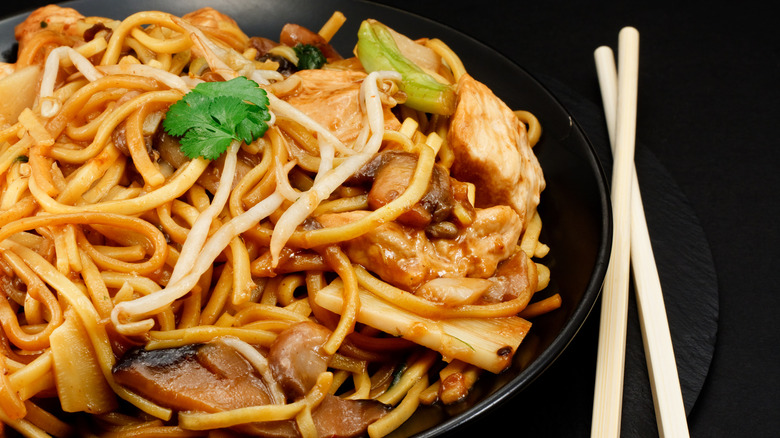The Key To Making Great Chow Mein, According To Jet Tila - Exclusive
Here in the West, there may be no single dish that epitomizes the culinary juggernaut of Chinese takeout like chow mein. The pan-fried noodle dish never fails to make for an umami-rich, flavorful, and comforting meal no matter where you get it from. While the traditional recipe is made simply with onions, bean sprouts, soy sauce, and a handful of other typical Asian condiments, these days, chow mein can be altered to suit any appetite, and you'll find iterations made with chicken, beef, pork, shrimp, tofu, a rainbow of veggies, and more.
But for a dish that is so universally beloved — and adaptable, especially within a Western context — it can be surprisingly difficult to master. There are a lot of potential mistakes to be made when cooking chow mein. With that in mind, we turned to an expert for the most important piece of advice to remember when it comes to this popular dish.
Jet Tila is known as the ambassador of Thai food here in the U.S., but his culinary expertise spans Pan-Asian cuisines and beyond. From Chinese cuisine to traditional Vietnamese fare to Japanese favorites, Tila's repertoire proves what a multi-faceted chef and culinary educator he is. And there's absolutely no doubt that he knows exactly what it takes to make a mean chow mein. Speaking exclusively with Tasting Table, Tila shared the most important thing to keep in mind when whipping up this quintessential Chinese food staple at home.
The noodles will make or break your chow mein, says Jet Tila
While the sauce is certainly significant, and the fillings can aid in both flavor and nutritional content, the noodles are the most important aspect of chow mein, according to Jet Tila. If you're looking to make it yourself — the right way — Tila insists "it's about finding the right noodles" and treating them properly. Traditional Chinese egg noodles are what you need for the best results. While there was a time they might have been nearly impossible to find unless you made your way to the right Asian market, luckily, times and palates have changed, and Tila noted, "In most cities in America, you'll be able to find them now."
Once you've got the right noodles, how you prepare them makes all the difference with chow mein. It's easy to get this dish confused, both in idea and practice, with lo mein. Tila explained, "'Lo' means 'stir.' Stir usually connotes soft noodles. 'Chow' means to 'fry.'" Thus, "If you're doing a chow mein, which a lot of cooks would consider crispy noodles, start with a steamed chow mein noodle," which you'll want to quickly flash fry in a small pan or wok of hot oil until the noodles start crisping up. Only after they reach their desired texture should you mix in your sauce and fillings — and sparingly, since the noodles are the star here.
Tila warned, "You don't want a noodle that you boil — that's more of a lo mein." That's closer to your basic stir fry, where the noodles, protein, veggies, and sauce are all cooked together. There's also no use trying to "'chow' your pasta ... to go from wet to [frying it] ... It won't ever get crispy. It's an impossibility." Instead, he said, "Get the noodles right; get something that's durable" from the beginning, and your homemade chow mein is bound to stand up to, if not outshine, your local takeout version every time.
Keep up with the latest from Jet Tila by following him on Instagram and YouTube.

